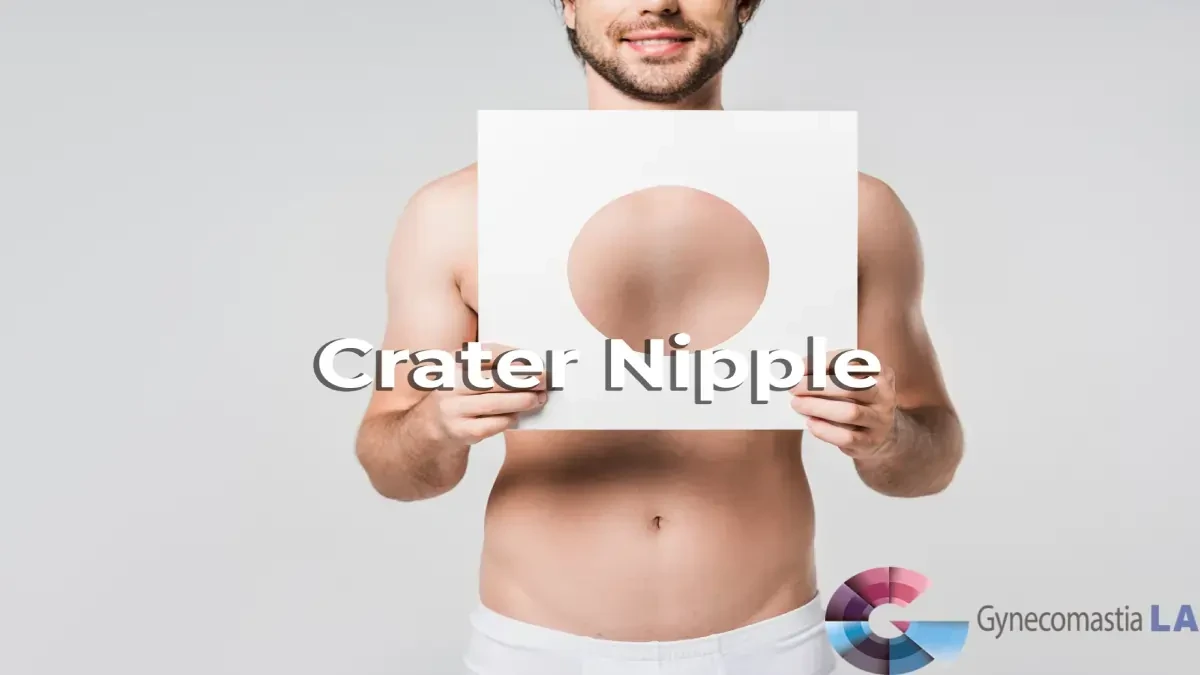What is a Crater Nipple Deformity?
Crater Nipple Deformity is a potential complication that can occur following gynecomastia surgery. It is characterized by the appearance of an indentation or hollow area under the nipple, resulting in a concave contour. This deformity is caused by the inadequate removal of glandular tissue without properly addressing the excess fatty skin around the nipple.
During gynecomastia surgery, it is important to remove both glandular tissue and any excess fat. However, if only the glandular tissue is removed without addressing the fatty skin, it can create an imbalance and lead to the formation of a concave contour under the nipple. This is commonly referred to as Crater Nipple Deformity.
To prevent the development of this deformity, certain key factors must be assessed during the preoperative assessment. Firstly, the surgeon should evaluate the ratio of glandular tissue to fatty tissue in the breast. This can be done through physical examination and imaging techniques such as ultrasound or mammography. Additionally, the elasticity and quality of the skin should be assessed to determine if it can adequately adjust to the new contour after surgery.
In conclusion, Crater Nipple Deformity following gynecomastia surgery is characterized by the appearance of an indentation or hollow area under the nipple due to the inadequate removal of glandular tissue without addressing the fatty skin. A thorough preoperative assessment, including the evaluation of glandular tissue, fatty tissue, and skin quality, is essential to prevent the development of this deformity.

Causes of Crater Nipple Deformity
Crater nipple deformity is a potential complication that can occur after gynecomastia surgery. It is characterized by an indentation or concavity around the areola, giving it a sunken appearance. Several causes contribute to the development of this deformity.
One of the main causes is overly aggressive removal of breast tissue. In an attempt to achieve a flat and sculpted chest contour, excessive tissue removal can lead to a depression around the areola. This over-resection of tissue creates a hollow or concave appearance, resulting in the crater nipple deformity.
Uneven liposuction is another factor that can contribute to this deformity. If fat is removed unevenly from the chest area, it can cause an imbalance in the contour of the chest. This unevenness can affect the distribution of tissue around the areola, resulting in a sunken appearance and the development of the crater nipple deformity.
To prevent the occurrence of this complication, plastic surgeons must assess certain key factors during the preoperative assessment. Breast volume, skin elasticity, and the ratio of glandular to adipose tissue should be carefully evaluated. Proper assessment of these factors allows for a more precise planning of the surgical technique required to achieve a balanced and aesthetically pleasing chest contour.
In conclusion, crater nipple deformity is an unfortunate complication that can occur after gynecomastia surgery. Overly aggressive tissue removal and uneven liposuction are major causes of this deformity. Plastic surgeons must thoroughly assess key factors during the preoperative assessment to ensure an optimal surgical outcome and prevent the development of this complication.
Who is a Candidate for Crater Nipple Deformity Correction?
Crater Nipple Deformity is a condition that some individuals may experience, where the nipple appears indented or sunken in. Crater Nipple Deformity Correction is a surgical procedure aimed at improving the appearance of the nipple and restoring a more natural shape.
To be considered a suitable candidate for Crater Nipple Deformity Correction, several criteria must be met. Firstly, the individual should be bothered by the appearance of their nipples and have a genuine desire to correct the deformity. Secondly, they should be in good overall health and have realistic expectations about the outcome of the procedure.
The evaluation process for determining the extent of the crater and surrounding tissues involves a thorough examination by a qualified plastic surgeon. During this evaluation, the surgeon will assess the severity of the deformity, taking into consideration factors such as the depth and size of the crater, as well as the elasticity of the surrounding skin. This assessment is crucial in determining the appropriate surgical technique and expected outcomes.
In conclusion, suitable candidates for Crater Nipple Deformity Correction are those who are bothered by the appearance of their nipples, are in good overall health, and have realistic expectations. The evaluation process involves a detailed assessment of the extent of the deformity and surrounding tissues by a plastic surgeon. Crater Nipple Deformity Correction can provide individuals with improved nipple appearance and boost their self-confidence.
Crater Nipple Deformity Correction
After gynecomastia surgery, one of the potential complications that may arise is the development of a crater nipple deformity. This deformity occurs when there is an indentation or concavity around the areola, giving it a sunken appearance. Fortunately, there are corrective procedures available to address this issue and restore a more natural contour to the chest.
The correction procedure for crater nipple deformity starts with a thorough evaluation of the depth of the crater and the presence of any excess tissue in the area. This assessment is crucial in determining the most appropriate technique to use for correction.
One technique that is commonly employed is the fat flap technique. This involves harvesting fat tissue from another area of the body, such as the abdomen or thighs, and using it to fill in the concavity around the nipple. The fat flap is carefully placed and secured within the indentation, creating a more rounded and smooth appearance.
Another option for correcting crater nipple deformity is fat grafting. With this technique, fat tissue is harvested from the patient’s own body and then injected into the concave area. This helps to even out the contour and improve the appearance of the nipple.
Both the fat flap technique and fat grafting are effective interventions for correcting crater nipple deformity after gynecomastia surgery. The choice of technique will depend on the individual patient’s needs and preferences, as well as the surgeon’s expertise. With the appropriate correction procedure, individuals can achieve a more symmetrical and aesthetically pleasing outcome.
Crater Nipple Deformity Repair Before and After Gallery
Crater nipple deformity is a complication that can occur after gynecomastia surgery, resulting in an unsightly appearance of the nipples. This condition is characterized by the formation of craters or depressions around the areola, giving the nipple a sunken-in appearance.
The before and after gallery for crater nipple deformity repair showcases the transformative effects of various treatment options. Visual examples of patients who have undergone corrective procedures demonstrate the improvement achieved after addressing this complication. These images emphasize the successful restoration of a natural and aesthetically pleasing nipple contour.
Crater nipple deformity can be caused by several factors, including over-resection of breast tissue and improper healing. When too much glandular tissue or fat is removed during gynecomastia surgery, it can lead to the formation of craters around the nipples. Additionally, improper healing can result in an uneven distribution of tissue and an abnormal contour.
Fortunately, there are several treatment options available to correct crater nipple deformity. One approach involves the use of fat grafting, in which fat cells are carefully harvested from another area of the body and then injected into the craters to fill them out. Dermal fillers can also be utilized to restore volume and create a more symmetrical appearance.
Proper assessment during the final stage of gynecomastia surgery is crucial to avoid and equalize any deformity. By meticulously evaluating the results and making any necessary adjustments, surgeons can effectively prevent the occurrence of crater nipple deformity.
In conclusion, the before and after gallery for crater nipple deformity repair exhibits the transformative effects of various treatment options. Understanding the causes and characteristics of this complication is key to selecting the appropriate treatment approach. By prioritizing proper assessment, surgeons can enhance the overall outcome of gynecomastia surgery, providing patients with natural-looking and aesthetically pleasing results.

Cost of Crater Nipple Deformity Repair
Crater nipple deformity is a potential complication that can arise following gynecomastia surgery. This condition occurs when there is an indentation or depression around the nipple-areolar complex, resulting in an unnatural appearance. The cost of repairing this deformity can be influenced by several factors.
First and foremost, the severity of the crater nipple deformity plays a significant role in determining the cost. Mild deformities may require simple techniques such as fat grafting, while more severe cases might necessitate complex surgical procedures like fat flaps. The complexity of the repair procedure directly impacts the cost.
Revision surgery is another factor that can affect the overall cost. In some instances, the initial surgery fails to adequately correct the deformity, leading to the need for further treatment. Revision surgery may involve additional expenses, such as surgeon fees, operating room charges, and anesthesia costs.
Furthermore, if fat transfer is required to address the crater nipple deformity, there will be associated costs. Fat transfer involves harvesting fat from one part of the body and injecting it into the affected area. This procedure typically incurs charges for liposuction, fat processing, and the actual transfer.
Additional expenses to consider include anesthesia fees and facility charges. These costs can vary depending on the location and the specific anesthesia techniques employed during the surgery. It is essential to factor in these expenses when estimating the overall cost of the procedure.
Researching and finding the right surgeon is crucial to minimize costs and achieve optimal results. Choosing an experienced and reputable surgeon who specializes in gynecomastia surgery can help reduce the likelihood of complications and the need for revision procedures. It is advisable to consult with multiple surgeons, inquire about their fees, and review their before-and-after photos to make an informed decision.
In conclusion, the cost of crater nipple deformity repair after gynecomastia surgery can be influenced by several factors, including the severity of the deformity, the need for revision surgery, the use of fat transfer or flap procedures, and additional expenses such as anesthesia fees and facility charges. Conducting thorough research and selecting the right surgeon is essential in minimizing costs and achieving desired outcomes.
Recovery for Crater Nipple Deformity
The recovery process for crater nipple deformity after gynecomastia surgery involves a combination of time, proper wound care, and potential corrective procedures. Crater nipple deformity refers to a concave or indentation appearance of the nipple-areola complex, which can occur as a complication of gynecomastia surgery.
The initial healing time for gynecomastia surgery typically spans a few weeks, during which patients are advised to avoid strenuous activities and follow post-operative care instructions to minimize complications. Crater nipple deformity may become apparent during this healing period or several weeks after the surgery.
In cases where crater nipple deformity occurs, the primary treatment option involves tissue grafting. This corrective procedure aims to fill the concavity by transferring tissue from a donor site, such as the areola or surrounding tissue, to the affected area. Additional surgical techniques, such as fat grafting or dermal matrix placement, might be incorporated to enhance the outcome.
The recovery time following tissue grafting for crater nipple deformity varies, with patients typically advised to limit physical activities for about three to four weeks. Full healing and optimal results may take several months.
Overall, the recovery process for crater nipple deformity necessitates patience, proper wound care, and potential corrective procedures. Following the treatment plan prescribed by a qualified plastic surgeon is essential to ensure the best possible outcome.
Conclusion: Crater Nipple Deformity
In conclusion, crater nipple deformity is a potential complication that can occur after gynecomastia surgery. This deformity is characterized by a sunken or concave appearance of the nipple and areola complex, which can greatly affect the aesthetic outcome of the chest area.
The primary cause of crater nipple deformity is excessive removal of glandular tissue during the surgery, resulting in insufficient support for the nipple and areola. Other contributing factors may include improper surgical technique, poor wound healing, or underlying anatomical variations.
Symptoms of crater nipple deformity include a depressed or indented appearance of the nipple and areola, which can lead to self-consciousness and dissatisfaction with the surgical result. Some patients may also experience discomfort or pain in the affected area.
Treatment options for crater nipple deformity include fat grafting, dermal fillers, or the use of acellular dermal matrix to provide added support and volume to the damaged area. These techniques aim to restore a more natural contour and projection to the nipple and areola complex.
Proper assessment during the final stage of surgery is of utmost importance to avoid the development of crater nipple deformity. This includes meticulous evaluation of the amount of glandular tissue which needs to be removed, identification of any anatomical variations, and ensuring adequate support and tissue coverage for the nipple and areola.
In summary, careful consideration of the causes, symptoms, and potential treatment options for crater nipple deformity is crucial to achieve a successful outcome in gynecomastia surgery. Employing proper assessment techniques and utilizing appropriate correctional procedures can greatly improve the aesthetics of the chest area and enhance patient satisfaction.

Dr.Babak Moeinolmolki
LA Cosmetic Surgeon Dr. Moein is board-certified by the American Board of General Surgery.
